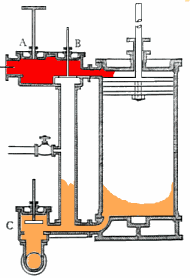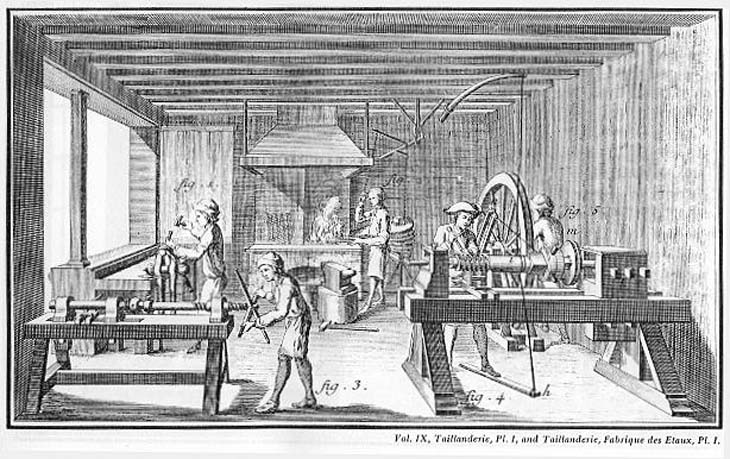




From water power to steam driven machinery the industrial means of production altered people's lives by reorganizing humanity's relationship with natural elements and changing what people did to earn a living.
Steam engines –as they became more versatile were freed of being tied to one place as shown below in the earler type of Newcomen engine– had a widespread impact on industrial applications, transportation and eventually automation.

Tectonic | socio-technic / organizational | symbolic/ ideo-technical
![]()
Oliver Evans was an American inventor in the 18th century.
"The time will come when people will travel in stages moved by steam engines from one city to another, almost as fast as birds can fly, 15 or 20 miles an hour.... A carriage will start from Washington in the morning, the passengers will breakfast at Baltimore, dine at Philadelphia, and sup in New York the same day.... Engines will drive boats 10 or 12 miles an hour, and there will be hundreds of steamers running on the Mississippi, as predicted years ago."
Oliver Evans, 1800
| He perfected a completely automated flour mill and the steam driven wagon-vehicle. | |
|
Evan's automated mill based on the Archimedean screw |
Oliver Evan's Oruktor Amphibolus |
By exapting what he had learned and knew about expansion and condensing of air in steam engines, Evans perfected a condenser for refrigeration (air-conditioning) in the 19th century, far ahead of his times with regards to the manufacturing techniques, the markets, and the popular demands of three to six million Americans.
 |
 |
|---|---|
| Screw makers in a shop were antecedent techniques and tools to many other mechanically dependent technological developments. | |
So what happens when a steam engine is adapted from a stationary position to movable positions?
![]()
The early steam locomotive, railroad engine.
1829, "mechanical drawing" of the exterior and interior of the "Tom Thumb:" compared to a photograph of an early locomotive.
Peter Cooper of New York in 6 weeks time built the Tom Thumb, a vertical boiler 1.4 HP (horse power) locomotive, for the Baltimore & Ohio Railroad.
Peter Cooper's steam locomotive hauled 36 passengers at 18 mph in August 1830. It had a revolving fan for draught, used gun barrels for boiler tubes, and weighed less than one ton.
![]()
A Widespread ideo-technical appeal of the locomotive in the nineteenth century iconography of technical inventions
It was not such an immediate success, as it was a signal, of fast transportation changes yet to come. Steam locomotion set in place a series of transformations that would profoundly alter space and time before it was even fifty years old. Born of the English industrial need for coal extraction from ever deeper mines, the locomotive run by steam consumed wood to boil the water. So, eventually, due to such consumption of timber and water resources railways became a major investor in land, development and banking. Peter Cooper's engine became a symbol of extravagant opportunities and unbelievable changes in society, economics, politics, and environmental sciences.
As a corporate institution the Baltimore & Ohio Railroad was the means by which a small revolution in machinery led to a huge change in the use of resources, the organization and management of labor and the transformation of the nations that employed railways to replace canals as the principle form of mass transportation.
 |
||
| Technology was moving from the instrument scale of precision watches and more durable metals to the mechanized level of operation. This mean that a reliable source of power was necessary and such a change laid the foundations for steam engines. The proficient use of steam led to even more extensive use of machinery than anyone could have imagined. One impact was a rapid transforming of the Enlightenment's hopes for progress into the industrial realities of a mechanically engineered world. | ||
| The steam engine was a significant coming together of specialties. This culmination of metal craft, furnaces, gears, wagon designs, and machinery was as much dependent on the revolutionary triumph of the machinists and the metallurgists, as it was on the new improvements made to the device itself. | ||
| The locomotive application of the steam-engine to railway transport. | ||
  |
||
| How the device works | The "Tioga" was an early locomotive | |
Pursell | Pacey–World| Pacey–Meaning | Tenner | Postman | Eberhart | Snow | Kaku
 |
||
|---|---|---|
| Tools of Toil: what to read. | ||
| Tools are historical building blocks of technology. | ||
Pursell | Pacey–Meaning | Pacey | Tenner | Postman–Tech | Postman–Television | Eberhart | Snow | Kaku